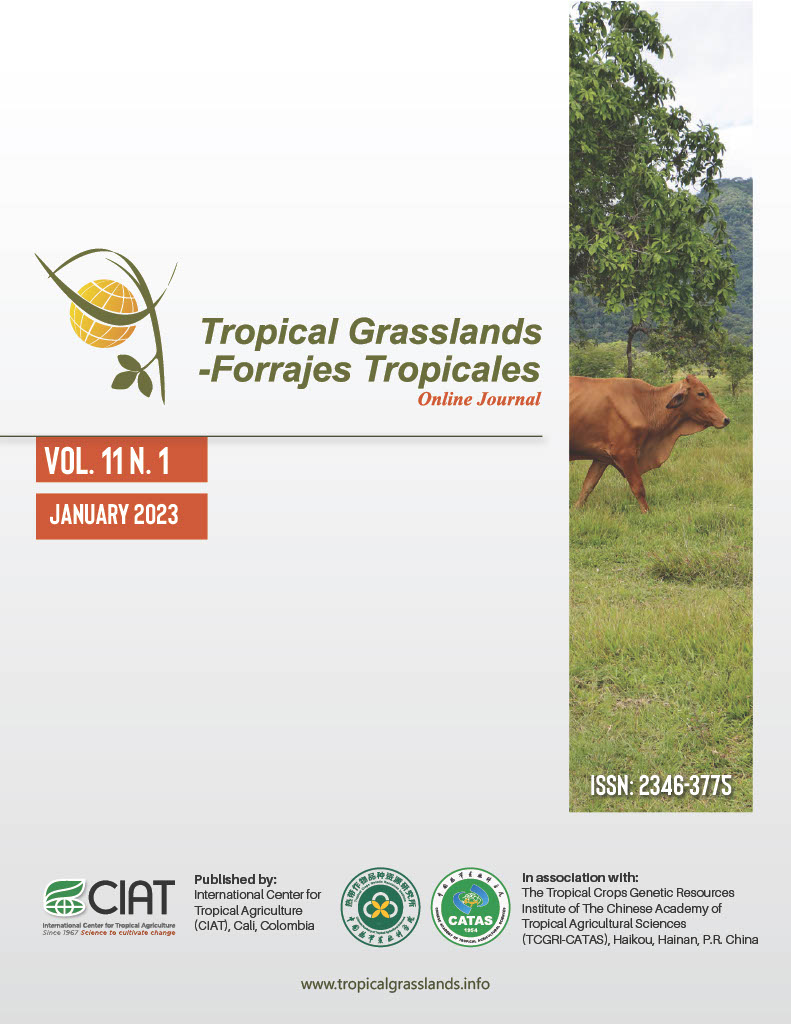Effect of irrigation on biomass production and components of dallis grass (Paspalum dilatatum) and Bahia grass (P. notatum) in Uruguay
DOI:
https://doi.org/10.17138/tgft(11)22-30Abstract
Use of irrigation in forage production systems based on perennial C4 grasses has been limited because of inconsistent responses of biomass production to water. The effects of three different levels of irrigation on growth of Paspalum notatum (Bahia grass) and P. dilatatum (dallis grass) over two consecutive growing seasons were studied. The phenological state of the plants was inferred by the proportion of lamina and non-lamina components. While irrigation failed to increase annual dry matter yield of forage, phenological composition of forage was affected by irrigation with both species showing changes in distribution of dry matter accumulation among different above-ground plant parts. Future research on these species should study the effects of moisture deficit on phenology to better understand the effects of irrigation.
References
Adjei MB; Mislevy P; Chason W. 1992. Seed yield of bahiagrass in response to sward management by phenology. Agronomy Journal 84(4):599–603. doi: 10.2134/agronj1992.00021962008400040011x
Allen RG; Pereira LS; Raes D; Smith M. 2006. Evapotranspiración del cultivo: Guías para la determinación de los requerimientos de agua de los cultivos. Estudio FAO Riego y Drenaje Nº 56. bit.ly/3WJz5cR
Altaminino A; Silva H da; Duran A; Echevarría A; Panario D; Puentes R. 1976. Carta de reconocimiento de suelos del Uruguay. Tomo I: Clasificación de suelos. Ministerio de Ganadería Agricultura y Pesca, Montevideo, Uruguay. 97 p. bit.ly/3vEN7AQ
Beaty ER; Stanley RL; Powell J. 1968. Effect of height of cut on yield of Pensacola Bahiagrass. Agronomy Journal 60(4):356–358. doi: 10.2134/agronj1968.00021962006000040007x
Beaty ER; Smith YC; Powell JD. 1974. Response of Pensacola bahiagrass to irrigation and time of N fertilization. Journal of Range Management 27(5):394–396. bit.ly/3GE70ht
Biran I; Bravdo B; Bushkin-Harav I; Rawitz E. 1981. Water consumption and growth rate of 11 turfgrasses as affected by mowing height, irrigation frequency, and soil moisture. Agronomy Journal 73(1):85–90. doi: 10.2134/agronj1981.00021962007300010020x
Castaño JP; Giménez A; Ceroni M; Furest JM; Aunchayna R; Bidegain M. 2011. Caracterización agroclimática del Uruguay 1980-2009. Instituto Nacional de Investigación Agropecuaria (INIA), Montevideo, Uruguay. Serie Técnica 193. bit.ly/3WJgMVt
Costa DI da; Scheffer-Basso SM. 2003. Morphophysiological and agronomic characterization of Paspalum dilatatum Poir. biotype Virasoro and Festuca arundinacea Schreb: 1. Morphological development. Revista Brasileira de Zootecnia 32(5):1054–1060. (In Portuguese). doi: 10.1590/S1516-35982003000500004
Cunha FF da; Soarez AA; Pereira OG; Lambertucci DM; Abreu FVS. 2007. Morphogenetic characteristics and tillering of irrigated Panicum maximum Jacq. cv. Tanzania. Ciência e agrotecnologia 31(3):628–635. (In Portuguese). doi: 10.1590/S1413-70542007000300005
Di Rienzo JA; Casanoves F; Balzarini MG; Gonzalez L; Tablada M; Robledo CW. 2018. InfoStat version 2018. InfoStat group, Faculty of Agricultural Sciences, National University of Córdoba. www.infostat.com.ar
Forde BJ; Slack CR; Roughan PG; Whitehead HCM. 1976. Growth of tropical and temperate grasses at Palmerston North. New Zealand Journal of Agriculture Research 19:135–142. doi: 10.1080/00288233.1976.10426759
Giménez A; Lanfranco B. 2012. Adaptation to climatic change and variability: some response options to agricultural production in Uruguay. Revista Mexicana de Ciencias Agrícolas 3(3):611–620. (In Spanish). doi: 10.29312/remexca.v3i3.1454
Giménez L; García Petillo M. 2011. Evapotranspiración de cultivos de verano para dos regiones climáticamente contrastantes de Uruguay. Agrociencia Uruguay 15(2):100–108. doi: 10.31285/AGRO.15.598
González-Barrios P; Speranza P; Glison N; Piccardi M; Balzarini M; Gutierrez L. 2016. Analysis of flowering dynamics heritability in the perennial warm-season grass Paspalum dilatatum. Grass and Forage Science 71(1):123–131. doi: 10.1111/gfs.12159
Harris W; Lazenby A. 1974. Competitive interaction of grasses with contrasting temperature responses and water stress tolerances. Australian Journal of Agricultural Research 25(2):227–246. doi: 10.1071/AR9740227
Jia X; Dukes MD; Jacobs JM. 2009. Bahiagrass crop coefficients from eddy correlation measurements in central Florida. Irrigation Science 28:5–15. doi: 10.1007/s00271-009-0176-x
Jordan JE; White RH; Vietor DM; Hale TC; Thomas JC; Engelke MC. 2003. Effect of irrigation frequency on turf quality, shoot density, and root length density of five bentgrass cultivars. Crop Science 43(1):282–287. doi: 10.2135/cropsci2003.2820
Kiniry JR; Kim S. 2020. A review of modeled water use efficiency of highly productive perennial grasses useful for bioenergy. Agronomy 10(3):328. doi: 10.3390/agronomy10030328
Lopes RR; Franke LB. 2011. Seed production from four Paspalum ecotypes native from Rio Grande do Sul. Revista Brasileira de Zootecnia 40(1):20–30. (In Portuguese). doi: 10.1590/S1516-35982011000100004
Marais D; Rethman N; Annandale J. 2006. Dry matter yield and water use efficiency of five perennial subtropical grasses at four levels of water availability. African Journal of Range & Forage Science 23(3):165–169. doi: 10.2989/10220110609485900
McCormick LH; Boschma SP; Lodge GM; Scott JF. 2009. Producer-identified constraints to widespread adoption of sown tropical grass pastures on the north-west slopes of New South Wales. Tropical Grasslands 43:263–266. bit.ly/3Ggwxw2
Mislevy P; Everett PH. 1981. Subtropical grass species response to different irrigation and harvest regimes. Agronomy Journal 73(4):601–604. doi: 10.2134/agronj1981.00021962007300040008x
Neal JS; Fulkerson WJ; Sutton BG. 2011. Differences in water-use efficiency among perennial forages used by the dairy industry under optimum and deficit irrigation. Irrigation Science 29:213–232. doi: 10.1007/s00271-010-0229-1
Ogata S; Saneoka H; Matsumoto K. 1985. Nutritio-physiological evaluation of drought resistance of warm season forage crops. Proceedings of the XV International Grassland Congress, Kyoto, Japan. Vol 15, p. 407–409.
Owensby CE; Hyde RM; Anderson KL. 1970. Effects of clipping and supplemental nitrogen and water on loamy upland bluestem range. Journal of Range Management 23(5):341–346. doi: 10.2307/3896163
Pereira HH; Avila Jacques AV; Leal Barreto I. 1978. Efeito da altura de corte e estadios de crescimento sobre a producão de materia seca, concentracão e glicidios e proteína bruta em Paspalum dilatatum, POIR ecotipo Antera Amarela. Anuário técnico do Instituto de Pesquisas Zootécnicas 1:325–335.
Pezzopane CG; Lima AG; Cruz PG da; Beloni T; Fávero AP; Santos PM. 2017. Evaluation and strategies of tolerance to water stress in Paspalum germplasm. Tropical Grasslands-Forrajes Tropicales 5(3):153–162. doi: 10.17138/tgft(5)153-162
Rodrigues BHN; Magalhães JA; Lopes EA. 2005. Irrigation and nitrogen fertilization of three forage grasses in Middle-North of Brazil. Revista Ciência Agronômica 36(3):274–278. (In Portguese). bit.ly/3ZmJiOm
Royo Pallarés O; Berretta EJ; Maraschin GE. 2005. The South American Campos ecosystem. In: Suttie JM; Reynolds SG; Batello C, eds. 2005. Grasslands of the World. Food and Agriculture Organization of the United Nations, Rome, Italy. p. 463–514. bit.ly/3ilg95c
Sinclair TR; Schreffler A; Wherley B; Dukes MD. 2011. Irrigation frequency and amount effect on root extension during sod establishment of warm-season grasses. Horticultural Science 46(8):1202–1205. doi: 10.21273/HORTSCI.46.8.1202
Snyman HA. 1994. Evapotranspiration, water-use efficiency and quality of six dryland planted pasture species and natural vegetation, in a semi-arid rangeland. African Journal of Range & Forage Science 11(3):82–88. doi: 10.1080/10220119.1994.9647852
Speranza P. 2017. Utilización y domesticación de gramíneas forrajeras del género Paspalum en Uruguay. INIA-Proyecto FPTA-177. Introducción y domesticación de gramíneas forrajeras estivales perennes nativas. Montevideo, Uruguay. bit.ly/3vGmWd4
Stone KC; Bauer PJ; Andrae J; Busscher WJ; Millen JA; Strickland EE; Evans DE. 2012. Irrigation and nitrogen impact on bermudagrass yield response in the Southeastern Coastal Plain. American Society of Agricultural and Biological Engineers 55(3):969–978. doi: 10.13031/2013.41528
Tejera M; Speranza P; Astigarraga L; Picasso V. 2015. Forage biomass, soil cover, stability and competition in perennial grass–legume pastures with different Paspalum species. Grass and Forage Science 71(4):575–583. doi: 10.1111/gfs.12208
Thornthwaite CW; Mather JR. 1955. The water balance. Centerton: Drexel Institute of Technology, Laboratory of Climatology. Publications in Climatology 8. 104 p.
Vaio M; Mazzella C; Guerra M; Speranza P. 2019. Effects of the diploidisation process upon the 5S and 35S rDNA sequences in the allopolyploid species of the Dilatata group of Paspalum (Poaceae, Paniceae). Australian Journal of Botany 67(7):521–530. doi: 10.1071/BT18236
How to Cite
Downloads
Downloads
Published
Issue
Section
License
Copyright (c) 2023 Tropical Grasslands-Forrajes Tropicales

This work is licensed under a Creative Commons Attribution 4.0 International License.




